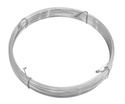Resources
Trellis Wire
Many types of trellises can be constructed quickly and easily with MAX-TEN 200 High-Tensile Trellis Wire. Such trellises last longer and cost less. Here is why:
HIGHER ELASTIC LIMIT, GREATER BREAKING STRENGTH
With adequate posts and brace assemblies, the principal cause of failure of any wire trellis is exceeding the elastic limit of the wire. As its name implies, 12 1/2 gauge MAX-TEN 200 High-Tensile Trellis Wire has a minimum ultimate tensile strength of 200,000 psi which is considerably higher than that of conventional trellis wire. It is also considerably stronger than the barbed wire and plastic-coated wires that have been used for some trellis applications. Unlike low-tensile wire, MAX-TEN 200 High-Tensile Trellis Wire can be pulled up tighter along an entire trellis line. This results in a stronger, straighter, more effective support system with no loose or sagging wires to serve as starting points for stretching and breaking-and ultimate failure of the trellis.
GREATER SUPPORT
MAX-TEN 200 High-Tensile Trellis Wire has higher breaking strength than conventional trellis wire, which means that even after it is placed under the recommended 250 pounds tension, each strand can withstand up to an additional 1,200 pounds of live loads and cold weather contraction without sagging. This superior resistance to stretching and breaking by loads or temperature changes practically eliminates trellis maintenance.
LONGER RESISTANCE TO CORROSION
The second most common cause of failure in trellis wire is atmospheric corrosion. The American Society for Testing and Materials has studied how galvanizing delays the rusting of steel wire under a wide range of climatic conditions. Most kinds of conventional low tensile trellis wire have only a Class 1 zinc coating or less. But MAX-TEN 200 High-Tensile Trellis Wire has Class 3 Galvanizing, which means it has a 250 percent heavier coating of zinc than many types of wire. This heavier coating can extend the life of MAX-TEN 200 High-Tensile Trellis Wire up to 35 years in humid regions, and to more than 50 years in drier climates. This is more than twice the life of Class 1 Galvanized Wire. (See Tables 4 and 5.)
VERSATILITY
MAX-TEN 200 High-Tensile Trellis Wire can be used to build many of the advanced support systems developed overseas, which are now being adapted to the high production requirements of American orchards and vineyards. The wire's versatility also lends itself to modification or expansion of trellises in the future. The system is compatible with such trends as: new planting outside traditional growing regions; planting on previously unusable terrain; concentrated planting with dwarf stock; and pick-it-yourself operations.
WELL-RESEARCHED
Until recently, most of the technology and practical experience in advanced trellis construction had been confined to countries where the concepts were developed. Today, research programs on trellises built with high-tensile wire are underway at several American universities. Complete horticultural and economic results cannot be known until the trees are in full production. However, experience with the initial installations indicates that the new trellises can help increase fruit production, reduce trellis maintenance and provide rapid returns on investment.
MAX-TEN 200 High-Tensile Trellis Wire and other components used to build high-tensile wire fences and trellises have been analyzed and tested by United States Steel's Research Laboratory which, in 1978, initiated a comprehensive research and development program to determine specifically which materials, hardware and accessory items-as well as techniques of construction- would be most reliable for use with MAX-TEN 200 High-Tensile Trellis Wire. Tests included wire, posts and other components used in building fences, but many of the tested materials and construction techniques are identical to those used in building high-tensile wire trellises.
CONTINUING TESTING PROGRAM
This continuing program has, to date, involved performing more than 130 physical tests to determine such properties as:
- The minimum ultimate tensile strength, yield strength and breaking strength of MAX-TEN 200 High-Tensile Trellis Wire, compared with other types of wire.
- The comparative breaking strengths and the mechanics of failure of various knots and mechanical devices used in fastening, splicing and tensioning MAX-TEN 200 High-Tensile Trellis Wire.
- The tension loading to destruction of various hardware and accessory items that can be used with MAX-TEN 200 High-Tensile Trellis Wire.
APPLICABILITY VERIFIED
Although MAX-TEN 200 High-Tensile Trellis Wire's outstanding physical characteristics were known and documented by years of service in other applications, there were many unanswered questions about its agricultural applications. Most of the technology and practical experience in high-tensile wire trellis construction had been developed overseas, particularly in Australia and New Zealand, and was not well known in this country.
HIGH-TENSILE WIRE TRELLIS MATERIALS
The new type trellises can outlast the life of trees and vines, and even support a second or third planting, so it is essential that only strong, long-lasting components be used. The total support system must be carefully planned and erected so that the trellis will perform as intended. Until recently, support systems were often considered secondary to the planting and were sometimes an afterthought. However, with the advent of new growing stock and the introduction of advanced support systems and materials, the trellis has become an integral part of the growing stock system. Because of the longevity of these new systems, the grower must plan for decades ahead. To get a good return on his investment, he must select a system that will last. This may mean spending more on the initial installation, but results in a system which will perform for years. During that time the trellis can pay for itself with increased production and lower operating costs; so, in the long run, a high-tensile wire trellis does not costâ¦it pays.
Building high-tensile wire trellises is no more difficult than other types, but high-tensile wire trellises are different and require special attention to the materials of construction. Following are brief descriptions of the basic materials common to all types of high-tensile wire trellises. By paying particular attention to these basics-the posts, wire and hardware-it is possible to build a superior trellis that will last for years, practically without maintenance.
CAUTION: Posts in contact with Quik-VISE fasteners or MAX-TEN® 200 High-Tensile Trellis Wire should not be treated with ACA (ammoniacal copper arsenate), which can cause corrosion problems.
TABLE 3. Comparison of Various Types of Wire Which Have Been Used For Trellises
Tested Brand |
Description |
Gauge No. |
Nom. Dia. (in.) |
Breaking Strength* |
Wt. of Zinc Coating (Oz/Ft.2) |
Ft/lb. (approx.) |
|
Pounds |
Psi |
||||||
A |
Vinyl-coated |
15 |
.073 |
350 |
83,600 |
.19 |
72.17 |
B |
Vinyl-coated |
13 1/2 |
.086 |
450 |
77,500 |
.87 |
49.87 |
C |
Uncoated |
9 |
.147 |
800 |
47,100 |
None |
17.08 |
D |
Vinyl-coated |
9 1/2 |
.143 |
1250 |
77,800 |
.16 |
18.55 |
E |
Uncoated |
8 |
.162 |
1640 |
79,600 |
None |
14.26 |
| MAX-TEN | MAX-TEN 200 |
12 1/2 |
.099 |
1655 |
216,050 |
.80 |
38.17 |
* Results are average of two tests.
TABLE 4. Minimum Weights of Zinc Coating on Wire*
Wire size |
Amount of galvanizing |
||
Class 1 |
Class 2 |
Class 3 |
|
9 |
.40 |
.60 |
.80 |
11 |
.30 |
.50 |
.80 |
12 1/2 |
.30 |
.50 |
.80 |
14 1/5 |
.20 |
.40 |
.60 |
*From ASTM designation A641
TABLE 5. Approximate Protection Given Wire by Class 1 and Class 3 Galvanizing*
Wire size |
Years till rust appears |
Years after rust appears until wire reaches half strength |
|||||||
Climatic condition |
Climatic condition |
||||||||
|
Dry |
Humid |
Coastal & industrial |
Dry |
Humid |
Coastal & industrial |
|||
Class |
Class |
Class |
|
|
|
||||
1 |
3 |
1 |
3 |
1 |
3 |
||||
9 |
15 |
30 |
8 |
13 |
3 |
6 |
50+ |
50+ |
25 |
11 |
11 |
30 |
6 |
13 |
2 |
6 |
50+ |
50+ |
16 |
12 1/2 |
11 |
30 |
6 |
13 |
2 |
6 |
50+ |
50+ |
12 |
14 1/2 |
7 |
23 |
5 |
10 |
1.5 |
4.5 |
50 |
20 |
7 |
*From ASTM subcommittee A-05.15 report, dated Feb. 7, 1977
NOTE: For maximum corrosion resistance, MAX-TEN 200 High-Tensile Trellis Wire should not be attached to any bare metal materials such as unpainted steel posts or bare tie-backs or fasteners.
An excerpt from How To Build Orchard and Vineyard Trellises - 47 pages of detailed instructions for using Max-Ten high-tensile trellis wire for a stronger, longer-lasting support system. Free shipping on this great how to for trellis design and construction.













